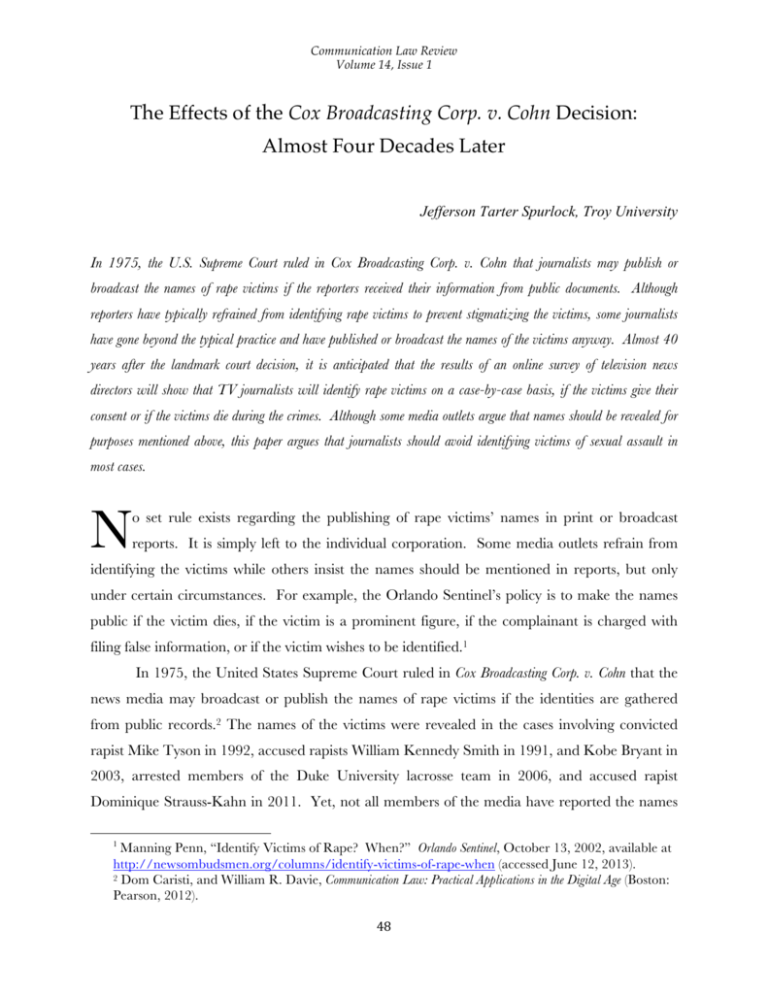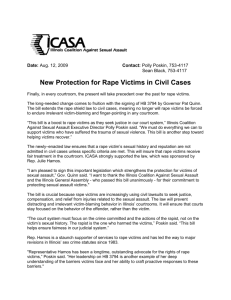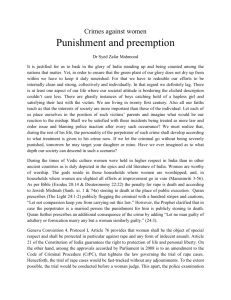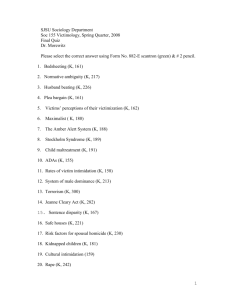The Effects of the Cox Broadcasting Corp. v. Cohn Decision
advertisement

Communication Law Review Volume 14, Issue 1 The Effects of the Cox Broadcasting Corp. v. Cohn Decision: Almost Four Decades Later Jefferson Tarter Spurlock, Troy University In 1975, the U.S. Supreme Court ruled in Cox Broadcasting Corp. v. Cohn that journalists may publish or broadcast the names of rape victims if the reporters received their information from public documents. Although reporters have typically refrained from identifying rape victims to prevent stigmatizing the victims, some journalists have gone beyond the typical practice and have published or broadcast the names of the victims anyway. Almost 40 years after the landmark court decision, it is anticipated that the results of an online survey of television news directors will show that TV journalists will identify rape victims on a case-by-case basis, if the victims give their consent or if the victims die during the crimes. Although some media outlets argue that names should be revealed for purposes mentioned above, this paper argues that journalists should avoid identifying victims of sexual assault in most cases. N o set rule exists regarding the publishing of rape victims’ names in print or broadcast reports. It is simply left to the individual corporation. Some media outlets refrain from identifying the victims while others insist the names should be mentioned in reports, but only under certain circumstances. For example, the Orlando Sentinel’s policy is to make the names public if the victim dies, if the victim is a prominent figure, if the complainant is charged with filing false information, or if the victim wishes to be identified.1 In 1975, the United States Supreme Court ruled in Cox Broadcasting Corp. v. Cohn that the news media may broadcast or publish the names of rape victims if the identities are gathered from public records.2 The names of the victims were revealed in the cases involving convicted rapist Mike Tyson in 1992, accused rapists William Kennedy Smith in 1991, and Kobe Bryant in 2003, arrested members of the Duke University lacrosse team in 2006, and accused rapist Dominique Strauss-Kahn in 2011. Yet, not all members of the media have reported the names 1 Manning Penn, “Identify Victims of Rape? When?” Orlando Sentinel, October 13, 2002, available at http://newsombudsmen.org/columns/identify-victims-of-rape-when (accessed June 12, 2013). 2 Dom Caristi, and William R. Davie, Communication Law: Practical Applications in the Digital Age (Boston: Pearson, 2012). 48 Communication Law Review Volume 14, Issue 1 of sexual assault victims even if they have learned of the identities through public records. Melanie Sill, the former Executive Editor of the News & Observer in Raleigh, North Carolina writes, “This policy is accepted practice among most print and broadcast media in the United States.”3 Author Michelle Johnson echoes that by penning, “Use of names has little effect on how readers view either a rape story or the crime. Considering that and the possible harm to the victim, not naming the victim still seems to be the best policy”.4 While this sentiment may hold true among most journalists, there are some who wish it were not the best solution. Kevin Melrose, the former editor of The Parthenon, the student newspaper at Marshall University, took criticism in 1992 when the publication adopted a policy of printing both accusers’ and victims’ names in rape cases because of the Cox Broadcasting decision. Naming the victims did not necessarily add credibility to the stories. Simply, the publication had a legal right to do so.5 Even the university’s President J. Wade Gilley, condemned the policy and accused the newspaper as having a “smut mentality.”6 When Geneva Overholser was editor at The Des Moines Register, she commented, “The policy of my newspaper is not to use the name of rape victims. Yet, I surely wish it could be otherwise.”7 News organizations such as the Society of Professional Journalists and the Radio Television Digital News Association have codes of ethics, which recommend that journalists adhere to certain guidelines of integrity, honesty, and fairness. Additionally, they suggest ways of handing stories involving sexual assault victims. The RTDNA maintains in its code that reporters should “treat all subjects of news coverage with respect and dignity, showing particular compassion to victims of crime or tragedy.”8 So, how do television journalists react Melanie Sill,. “ N & O’s Decision to Identify Accuser was Made With Care” [Online forum comment], April 12, 2007, available at http://openline.medialine.com/showthread.php?t=12326 (accessed July 18, 2013). 4 Michelle Johnson, “How Identifying Rape Victim Affects Readers’ Perceptions,” Newspaper Research Journal 20, no. 2, Spring 1999, 64. 5 Ted Anthony, “West Virginia Campus Explodes Over Naming of Rape Victims: Privacy: Marshall University’s Student Newspaper is at the Center of a Debate Over Freedom of the Press and Sensitivity to Ordeal,” Los Angeles Times, November 15, 1992, available at http://articles.latimes.com/1992-11-15/news/mn-876_1_student-newspaper (accessed October 30, 2013). 6 Ibid. 7 Geneva Overholser, “Why Hide Rapes?” The New York Times, July 11, 1989, available at http://www.nytimes.com/1989/07/11/opinion/why-hide-rapes.html (accessed June 14, 2013). 8 Radio Television Digital News Association, “RTDNA Code of Ethics,” available at http://www.rtdna.org/article/rtdna_code_of_ethics (accessed May 4, 2013). 3 49 Communication Law Review Volume 14, Issue 1 to the naming of rape victims, almost 40 years after the landmark Supreme Court decision in Cox Broadcasting Corp. v. Cohn? Utilizing the results of an online survey to television news directors nationwide, this study will find that electronic journalists should not reveal the names of the victims in cases where more suffering by the victims may occur. Overview of Cox Broadcasting Corp. v. Cohn (1975) In August of 1971, Cynthia Leslie Cohn, a 17-year-old Georgia high school student attended a party where alcohol was being served in Sandy Springs, Georgia (a suburb of Atlanta). “She had quite a bit to drink and passed out. Later, she was found dead. Initially, police said the girl died of a drug overdose or alcohol poisoning. As expected, an autopsy showed Cynthia Cohn died by choking on her own vomit, but the autopsy also showed she had been raped. Seven months later, six teens who attended the party were charged with rape.”9 Intense media coverage soon followed. The following April, five of the defendants pleaded guilty to rape or attempted rape (the trial of the defendant pleading not guilty was set for a later date). Reporter Thomas Wassell from WSB-TV (owned by Cox Broadcasting Corp.), approached a court clerk during a recess and asked to see the indictment against the defendants. Much to Wassell’s surprise, the clerk complied with his request. He later insisted, “No attempt was made by the clerk or anyone else to withhold the name and identity of the victim from me or anyone else and the said indictments apparently were available for public inspection upon request."10 That night, Wassell identified the deceased victim in his report on the evening news. In May of 1972, the victim’s father, Martin Cohn, filed a lawsuit against WSB and Cox Broadcasting, claiming his family’s privacy rights had been violated. At the time, a Georgia law prohibited journalists from identifying rape victims in broadcast or print reports. A trial court ruled in Cohn’s favor. Attorneys for Cox Broadcasting appealed the decision but the Georgia Michelle Johnson, “Of Public Interest: How Courts Handle Rape Victims’ Privacy Suits,” Communication Law & Policy 4, no. 2, Spring 1999, 201, available at http://www.d.umn.edu/cla/faculty/jhamlin/3925/Readings/privacy.html (accessed February 3, 2014). 10 Cox Broadcasting Corp. v. Cohn-The Circumstances,” available at http://law.jrank.org/pages/23272/Cox-Broadcasting-Corp-v-Cohn-Circumstances.html (accessed June 9, 2013). See also Justia.com-US Supreme Court Center: Cox Broadcasting Corp. v. Cohn-420 U.S. 469 (1975), available at https://supreme.justia.com/cases/federal/us/420/469/case.html#F2 (accessed November 11, 2013). 9 50 Communication Law Review Volume 14, Issue 1 Supreme Court upheld the lower’s court decision. Cox Broadcasting then petitioned the U.S. Supreme Court, asking for a review of the Georgia statute’s legality. The case was argued on November 11, 1974, and an 8-1 decision was rendered in Cox Broadcasting’s favor on March 3, 1975. Delivering the opinion of the Court, Justice Byron White maintained that, “this right of the press, to publicize public information was of critical importance to America, because it allows American citizens to be aware of and make judgments on public business.”12 Additionally, White wrote We are reluctant to embark on a course that would make public records generally available to the media but forbid their publication if offensive to the sensibilities of the supposed reasonable man. Such a rule would make it very difficult for the media to inform citizens about the public business and yet stay within the law. The rule would invite timidity and self-censorship and very likely lead to the suppression of many items that would otherwise be published and that should be made available to the public. At the very least, the First and Fourteenth Amendments will not allow exposing the press to liability for truthfully publishing information released to the public in official court records.13 Justice William Rehnquist dissented in the opinion of the Court by insisting that Georgia Supreme Court did not give a final judgment or decree and that the US Supreme Court should send the case back to Georgia “for more jurisdiction.”14 Review of Literature Since the 1975 Cox Broadcasting Corp. v. Cohn decision, several legal scholars have written opinions about the case. Among them is Gary F. Giampetruzzi who argues that states should consider protecting the complainants by keeping the victims’ identities “classified and off the public record.”15 Another is Deborah W. Denno who contends that “courts need to consider how differently rape victims should be treated from other kinds of crime victims, and whether the non-disclosure net [of identifying rape victims] should be broadened to include others (including Sam Harrington, Cox v. Cohn: A Case Brief, available at http://samharrington.net/cox-v-cohn-acase-brief/ (accessed February 3, 2014). 13 Cox Broadcasting Corp. v. Cohn: 420 U.S. 469 (1975). See Caristi and Davie, 151. 14 Harrington (accessed February 3, 2014). 15 Gary F. Giampetruzzi, “Raped Once, But Violated Twice: Constitutional Protection of a Rape Victim’s Privacy,” St. John’s Law Review 66, no. 1, Winter 1992, 177. 12 51 Communication Law Review Volume 14, Issue 1 non-crime victims) whose identities, when revealed, could result in emotional or physical harm.16 Paul Marcus and Tara L. McMahon suggest that states should enact laws setting certain limits on the media’s disclosure of rape victims’ names. They write, “Imposing narrowly drawn restrictions will not severely inhibit the media or unduly limit the public’s right to know. What such restrictions will do, however, is provide significant protection to victims and witnesses to come forth and become involved in the prosecution of these crimes.”17 Additionally, numerous newspaper articles and opinions have surfaced nationwide regarding the naming of rape victims. Bob Steele, of the Nelson Poynter Scholar for Journalism Values at the Poynter Institute, supports the approach that allows the victims to give their consent to having their identities revealed.18 Kenna Griffin of Oklahoma’s Society of Professional Journalists’ Professional Chapter, writes, “Journalists pride themselves on being as objective as possible; on treating all people equally. The concept of equality is just one of the reasons editors think rape victims should be named.”19 The Winston- Salem Journal identifies alleged victims in all cases except those involving minors.20 Yet less than 30 miles away, the Greensboro News and Record usually does not print accusers’ names because it claims “rape carries a stigma.”21 Regarding the naming of deceased victims, 14-year-old rape victim Cherise Moralez’s name was published after she committed suicide. Single mother Susan Verstegen’s name was broadcast after 38-year-old Rodrigo Hernandez was executed in a Texas prison after being convicted of raping and murdering Verstegen.22 Deborah W. Denno, “Perspectives on Disclosing Rape Victims’ Names,” Fordham Law Review, 61, no. 5, 1993, 1131 17 Paul Marcus, and Tara L. McMahon, “Limiting Disclosure of Rape Victims’ Identities,” College of William & Mary Law School Scholarship Repository: Faculty Publications Paper 580, 1991, 1055. 18 Bob Steele, “Naming Rape Victims.” [Editorial]. Poynter (2002), available at http://www.poynter.org/latest-news/everyday-ethics/talk-about- (accessed May 6, 2011). 19 Kenna Griffin, “Survivor Identification: The Ethical Debate on Naming Rape Victims,” available at http://www.profkrg.com/wp-content/uploads/2007/12/ethics-naming-rape-victims.pdf (accessed December 13, 2013) 20 Elizabeth Culotta, “Naming Alleged Rape Victims: Two Policies Within 30 Miles,” American Journalism Review, 15, no.3 July/August 1992, available at http://www.ajr.org/article.asp?id=2008 (accessed December 9, 2012). 21 Ibid, 2. 22 Eva Ruth Moravec, “Rapist Executed for 1994 S. A. Murder,” available at http://www.mysanantonio.com/news/local_news/article/Man-is-executed-for-S-A-murder2737817.php (accessed February 4, 2012). 16 52 Communication Law Review Volume 14, Issue 1 Additionally, in 1977, the media identified Cathleen Crowell, a 16-year-old fry cook at a seafood restaurant near Chicago, when she told police that 22-year-old Gary Dotson, a high school dropout, had raped her in the backseat of a car. Dotson was found guilty of the crime and was sentenced to 25 to 50 years in prison. Eight years later, he was released when Crowell admitted that she had lied.23 The media also identified 18-year-old Illinois high school student Katrina Sedlock when she reported in 2013 that she had been raped while walking her dog. She was later arrested when she told authorities she had faked the story.24 The media have also reported the names of rape victims when the accusers have wished to tell their stories to the public. Michigan high school student Lauren Kyle told reporters about when she was sexually assaulted in 2013. She said she did not want to be a victim. Instead, she wanted to be “a role model for people speaking out.”25 It was the same for 93-year-old Indiana resident, Amelia Rudolph, who was allegedly raped by 17-year-old Iquise Taylor in 2013. She told the Indianapolis Star, “The reason I’m talking about it is because I want people to find out what kind of people there are that do things like that. It happened to me.”26 In 1999, Michelle Johnson conducted a study asking 232 students in an introductory mass communication class at a large public university to respond to questions regarding how identifying rape victims affects readers’ perceptions. She wrote, “It seems possible that people have strong feelings about privacy and rape but do not pay close enough attention to news stories about rape to notice invasions of privacy when they occur.”27 Little survey research on identifying rape victims in broadcast news reports has been conducted since Johnson’s study in 1999. This study will take a look at television news directors’ “Cathleen Crowell Makes False Accusation of Rape,” available at http://suite101.com/a/accuserin-dotson-rape-case-dies-a55499 (accessed October 17, 2013). 24 Elena Ferrarin, “False Rape Claim Hindered Elgin Murder Investigation, Police Say,” Daily Herald, March 15, 2013, available at http://www.dailyherald.com/article/20130315/news/703159743/?interstitial=1 (accessed October 21, 2013). 25 Julie Mack, “Rape Victim Tells Her Story: Lauren Kyle, a Portage Northern Senior, Launches ‘No Means No’ Campaign,” available at http://www.mlive.com/news/kalamazoo/index.ssf/2013/04/a_rape_victim_tells_her_story.html (accessed November 1, 2013) 26 Betsy Reason, “Rape Victim, 93, Shares Story in Hopes of Helping Others,” Indianapolis Star, September 13, 2013, available at http://www.usatoday.com/story/news/nation/2013/09/13/elderly-rape-victim-sharesstory/2810263/. 27 Johnson, 70. 23 53 Communication Law Review Volume 14, Issue 1 positions on identifying rape victims in broadcast reports and what, if any, changes have been made in the last 15 years. Method Two hundred, twenty-seven television news directors from around the country were randomly selected to take part in a voluntary questionnaire on the topic of identifying rape victims in broadcast reports. The names of the news directors were located from the individual stations’ web pages or through the News Blues web site, a site that identifies all current news directors at television stations in the United States.28 The survey was set up through the online service, CreateSurvey.com. The instrument consisted of 10 five-point, Likert type questions, with answers ranging from strongly disagree to strongly agree (see Appendix). Once the participants completed the questionnaire, their answers were automatically posted for quick review. The participants were asked not to reveal their identities or their individual stations. Only the responses to the market sizes of their particular stations were shown. This study’s findings were based on the following research questions: RQ1: Is identifying rape victims in television news reports vital or important to conveying the details of the story? RQ2: Should television reporters identify rape victims in news stories if they have discovered the victims’ names from public records? RQ3: Should television news reports identify rape victims if the accusers give their consent? RQ4: Should television news reports identify rape victims if the victims die during the crimes? Results Data were compiled and analyzed using SPSS version 21.0. Of the 227 television news directors who were randomly selected to take part in the survey, 58 men and women completed the questionnaire, a response rate of 25%. Thirty-six percent (n =20) of those news directors reported they have been employed at their respective stations for 2 years or less; 20% (n =11) indicated they have worked at their current stations for 3 to 5 years; 15% (n =8) have been News Blues, “News Directors by Market,” available at http://www.newsblues.com/Secure/Source/nd_market.cgi. 28 54 Communication Law Review Volume 14, Issue 1 employed at their current stations for 6 to 8 years; 5% (n =3) from 9 to 11 years; and, 24% (n =13) have been employed as news directors at their current stations for 12 years or more. Of the respondents, 79% (n=42) answered that they have not identified rape victims in any of their reports in the last 12 months while 21% (n=11) have identified rape victims in 1 to 5 reports during the past year. Of the 58 news directors who responded to the survey, 11% (n =6) answered they were employed at stations in the top 30 markets where New York City is market size number one and Hartford/New Haven, Connecticut is market size number 30. Four percent (n =2) of the respondents indicated they were employed at stations in market sizes 31 to 50 where Kansas City is market size number 31 and Memphis, Tennessee is market size number 50. Thirty-one percent (n =17) of the news directors responded they were employed at stations in the next 50 largest markets where New Orleans is market size number 51 and the Tri-Cities of Davenport, Iowa/Rock Island/Moline, Illinois make up market size number 100. Thirty-six percent (n =20) of the respondents represented stations Ft.Smith/Fayetteville/Springdale/Rogers, in the Arkansas is next 50 market largest size markets number 101 where and Odessa/Midland, Texas is market size number 150. Eighteen percent (n =10) of the news directors who completed the survey reported they were employed at stations in market sizes 151 and lower where Albany, Georgia is market size number 151 and Glendive, Montana is market size number 210.29 In reference to RQ1, the survey found that 92% (n =51) of the news directors disagreed or strongly disagreed with the statement that identifying rape victims in television news reports is vital to conveying the details of the story (see Figure 1). In reference to RQ2, the survey found that 93% (n =51) of the news directors disagreed or strongly disagreed with the statement that television reporters should identify rape victims in their news stories if they have found the victims’ names in public records (see Figure 2). In reference to RQ3, 51% (n =28) of the news directors agreed or strongly agreed that television news reports should identify rape victims if the victims give their consent (see Figure 3). In reference to RQ4, 55% (n =29) agreed or strongly The Nielsen Company, “Local Television Market Universe Estimates,” available at http://www.tvb.org/media/file/TVB_Market_Profiles_Nielsen_TVHH_DMA_Ranks_20132014.pdf. 29 55 Communication Law Review Volume 14, Issue 1 agreed that identifying rape victims in television news reports should be done if the victims die during the crimes (see Figure 4). Chi-square statistics were conducted to examine differences between all survey items and the variables of length of time as news director and market size. There were no statistically significant differences found. Figure 1. Identifying rape victims in television news reports is vital or important to conveying the details of the story. 56 Communication Law Review Volume 14, Issue 1 Figure 2. Television reporters should identify rape victims in their news stories if they have found the victims’ names in public records (i.e., police documents, court records). Figure 3. Television news reports should identify rape victims if the victims give their consent. 57 Communication Law Review Volume 14, Issue 1 Figure 4. Identifying rape victims in television news reports should be done if the victims die during the crimes. Discussion The decision by the United States Supreme Court in 1975 (in Cox Broadcasting Corp. v. Cohn) allowing the identification of rape victims in print and broadcast news reports (when the information is found in public documents) has not sparked a mass of newspapers and radio and television stations actually naming the accusers. The literature has shown that some media outlets have aired or published the identities of rape victims on a case-by-case basis, if the victims give their consent or if the victims die during the crimes. This study has shown that while a small percentage of news directors insist that identifying rape victims in television news reports is vital or important to conveying the details of the story, an overwhelming 92% maintain otherwise. At the same time, 93% of the news directors surveyed claim that identifying the names of rape victims should not be done even if the information is derived from public documents. However, 51% of those surveyed in this study responded favorably to identifying rape victims in television news reports if the victims give their consent. Additionally, 55% responded that identifying rape victims should be done in television reports if the victims die during the crimes. Also, while no law exists that refrains television news outlets from identifying rape 58 Communication Law Review Volume 14, Issue 1 victims if the information is obtained from public records, 74% of those surveyed responded that publishing the names is unethical. This study’s results hold true to earlier similar research and find that, although legal, television news reports will typically refrain from identifying rape victims if the information is discovered in public documents. Conclusion WeNews correspondent Robin Hindery writes, “Journalists argue there is a need to protect rape victims, that the naming of accusers serves no greater purpose and will only cause pain.”30 She quotes New York-based marketing strategist Davia Temin by writing, “Naming victims just doesn’t hold any humanistic value. It’s like victimizing them a second time.”31 With the availability of social media, Americans still derive much of their news information from television reports. In cases of rape, the victims have already suffered harm. Why expose them to more pain by having their identities revealed on TV? It is understandable if the accusers give their consent to the media allowing them to name them. But, to victims who survived the assaults and are opposed to having their identities known, what good does it serve for broadcasters to cite the Cox Broadcasting Corp. v. Cohn decision and report the names anyway? It serves no good whatsoever. While an overwhelming majority of the television news directors in this study maintained that identifying rape victims in TV news reports is not vital or important to conveying the details of the story, the small percentage of those broadcast executives who insisted otherwise should overlook the fact that they are legally permitted to identify the victims and consider the accusers themselves by refraining from disclosing their identities. For those broadcasters who deem it necessary to include the names of rape victims in news reports, additional research (including open ended questions) may be conducted to determine the extent to why they choose to identify the complainants and whether they find this inclusion necessary and important. Appendix Questionnaire on Identifying Rape Victims in Television News Reports Robin Hindery, “Debate on Naming Rape Accusers Continues,” available at http://womensenews.org/story/rape/040924/debate-naming-rape-accuserscontinues#.UrB6MI1kU7A (accessed December 15, 2013). 31 Ibid. 30 59 Communication Law Review Volume 14, Issue 1 1. Identifying rape victims in television news reports is vital to conveying the details of the story. 2. A. Strongly disagree B. Disagree C. Neutral D. Agree E. Strongly agree Identifying rape victims in television news reports demonstrates to audiences that broadcasters have done a thorough job in covering the story. A. Strongly disagree B. Disagree C. Neutral D. Agree E. Strongly agree 3. Television reporters should identify rape victims in their news stories if they have found the victims' names in public records (i.e., police documents, court records). A. Strongly disagree B. Disagree C. Neutral D. Agree E. Strongly agree 4. Identifying rape victims in television news reports is unethical. A. Strongly disagree B. Disagree C. Neutral D. Agree E. Strongly agree 60 Communication Law Review Volume 14, Issue 1 5. Television news reports should identify rape victims if the victims give their consent. A. Strongly disagree B. Disagree C. Neutral D. Agree E. Strongly agree 6. Identifying rape victims in television news reports should be done if the victims die during the crimes. A. Strongly disagree B. Disagree C. Neutral D. Agree E. Strongly agree 7. Identifying rape victims in television news reports should never be done. 8. A. Strongly disagree B. Disagree C. Neutral D. Agree E. Strongly agree In the past 12 months, approximately how many news reports has your television station aired that identified rape victims? A. 0 B. 1-5 C. 6-10 D. 11-15 E. 16 or more 61 Communication Law Review Volume 14, Issue 1 9. How long have you been news director at the television station where you are currently employed? A. 0-2 years B. 3-5 years C. 6-8 years D. 9-11 years E. 12 years or more 10. Which market size best describes your television station? A. Top 30 B. 31-50 C. 51-100 D. 101-150 E. 151-lower 62








